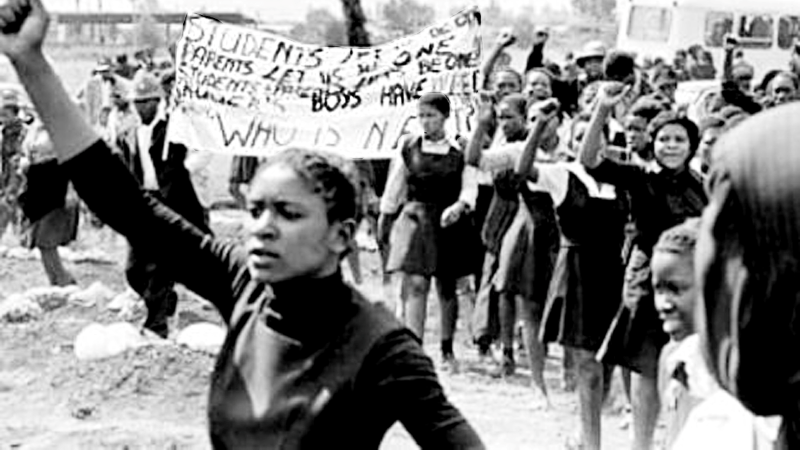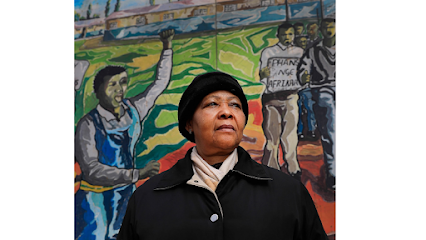"THE FUTURE IS YOURS TO MAKE"
In August of 2021 I was invited to speak at a forum reflecting on the 40th anniversary of Springbok Tour.
In 1981, I had been a young high school teacher, and since many of the attendees at the August forum were expected to be students, I prepared a short address, explaining how that winter of discontent had played out for me and my students half a lifetime ago.
As it turned out, the forum was cancelled beause of the Delta lockdown and my address and slideshow have sat on my computer since then.
I found them tonight and figured I might as well share. Late, but I reckon, still relevant.
I want to talk about the power of young people to change the world. About them taking the opportunity to raise their voices; to speak out for the present and for the future. To advocate for a world where their dreams can blossom – a planet that is habitable and fair for everyone.
What’s this got to do with the Springbok tour 40 years ago?
Well, in 1981 I was a teacher, working alongside young people around the age of most of you in the audience. Auckland Metropolitan College where I taught, was a small secondary school in Mount Eden - with a reputation for students who didn’t wear a uniform, sported outrageous hairstyles and often congregated in public places. Lots of people thought they were ‘out of control’.
But the truth was that Metro students were pretty much like
other 12 to 18 year olds at that time- with similar interests and dreams. What
made them different was that rather than being out of control – they were in
control. They ran their school.
The quote on the powerpoint slide encapsulates the code of Metropiltan College in 81 – a belief that true education is not a rehearsal for life; nor school a holding pen. Metro’s philosophy was that true education happens in the real world and school ought, wherever possible, emulate that world.
That’s why Metro
was a working democracy where students made all the decisions about how the
school operated. Metro students learned how to be citizens by governing their
school. They made all the rules and enforced them.
That may sound crazy - but let me tell you that the quality of debate and decision making in the student meetings where all decisions were made, surpassed that of all the school staff meetings I have ever attended. In my experience kids know what is important and given the chance will call out any unfairness and bullshit.
Alongside
the democratic governance, the classroom reinforced the philosophy of learning
through doing.
I taught a range of subjects at Metro, mostly in
social sciences and English. In everything, I tried to give learning application
to the real world. When we did history, we searched for its application in our
own lives.
We studied the social and political issues of our own time and very importantly we focused on social action, so that students could apply what they learned. We actively taught the art of the critical thought, argument and how to campaign. We taught the art of protest.
In my time
there, Metro students, of their own volition, organised campaigns both within their
school and in the community - around gender equality, gay rights, nuclear
disarmament, animal rights, an end to caning and strapping in schools, and of
course anti-racism.
So, it was
inevitable that they became swept up by the ‘81 anti-tour protests.
During the
build-up to the arrival of the Springboks, a particular incident from the
recent history of apartheid South Africa became their focus. Some of the
students had become aware of the Soweto uprising of 1976 and how young people their own age had been the catalyst of that event.
In ’76 Kids at a number of Soweto schools had gone on strike. They were outraged that, rather than learn their own indigenous languages alongside English, the government had decreed they spend 50 percent of their school time receiving instruction in Afrikaans, the hated language of apartheid. The education minister explained that since black children would grow up to work in white owned factories and farms, they needed to be able to take instructions from Afrikaans and English bosses. These languages took priority over their own.
The young students of Soweto said "no!"
As the strike spread, they organised a mass rally to publicise their cause - and on 16 June 1976 ten to 20,000 of them set off in orderly marches to gather at Orlando stadium.
They never made it.
They found their way blocked by armed police who beat them and set dogs on them.
Police then began to shoot the students.
One of the first to die that day was 12 year old Hector Pieterson, seen in this famous photo – carried in the arms of a fellow student with his sister Antoinette running alongside. The photographer has captured them running to escape the indiscriminate shooting - which killed 27.
In the days
that followed hundreds more were killed as Soweto township reeled into chaos.
Some touring All Blacks, visiting Soweto, accidentally found themselves in the right place for a spot of experiential learning when they were tear gassed.
The Metro students who learned about these events were particularly affected by them. These were kids their own age, killed while protesting the right to a decent education. A rugby team representing the child murdering regime was about to arrive here. They had to do something.
So when
Sophie Stockman from MOST (Mobilisation to Stop the Tour) approached the school
with an idea to commemorate the massacre of the students at Soweto on its 5th
Anniversary, the student population was all in. The plan was to do street
theatre in Aotea Square and rehearsals were done in the quadrangle behind the
school with everyone contributing ideas.
One memorable day an overseas advisor turned up to the rehearsal to offer advice.
It was banned South African journalist Donald Wood, friend and biographer of Black consciousness leader Steven Biko who had been murdered in police custody.
Wood coached the young actors in the correct pronunciation of the Nguni or Bantu chants of the Soweto students - and then in a truly remarkable hour he sat at the piano in the student common room and taught a bunch of kiwi kids to sing Nikosi Sikelele iAfrika the song that would one day become the anthem of post-apartheid South Africa.
The
re-enactment of the 16 June massacre in Aotea Square was one of those events
from 81, that has remained part of the remembered narrative. Mereta Mita and
her film crew captured the drama and included it in the documentary of the tour "Patu!"
Twice a week
for the length of the tour, Metro students organised to meet up and join in the
marches and special events.
Unsurprisingly,
some were arrested - for running onto the tarmac at Auckland Airport as the
boks arrived, and for occupying Eden Park. Several ran on to the field at
Hamilton, helping to force the cancellation of the game there. A number of them
were arrested there.
One of those
was 15 year old Chris who everyone at Metro knew as someone who could debate
you to a standstill. After half an hour in police custody Chris was unarrested
because police found his reasoned argument too damned annoying.
During the
second test, tiny year nine student Jennifer, turned up at the television
transmission station at Waiatarua, managed to get access, and opened the doors so
that 20 or so others could occupy the building and turn off the TV transmission
of the game to South Africa. How many South African rugby fans, up at 4 am to
watch their beloved Boks, ever knew that a 13 year old girl was responsible for
their TV blackout?
In
preparation for this talk I reached out to some of the Metro rangatahi from
that time. There were lots of vivid memories and comments about how their
activity during the tour and in other political and social causes had been the
best of education. They had learned about the importance of values and
developed skills to influence the future. It’s no accident that Metro produced
more than its share of union and community organisers, activist lawyers, media
people, musicians, artists and teachers.
A few of
those I spoke with recalled how, a couple of years after the tour they had
joined a group re-occupying Bastion Point to stop the sale of land there. They
recalled how, in 1983, they had leafletted and spoken at other schools across
the city, organising a student strike in opposition to the visit of the nuclear
warship Texas. They felt their efforts had, in a small way, prepared the path
for our modern climate change strikers.
The climate change movement among children and rangatahi is one of the most important of our time. The voices of young people have changed the narrative because adults find it impossible to argue with the future. That’s why many schools have stopped obstructing students and are encouraging them to give voice to their concerns.
Of course, it isn’t all plain sailing. Conservative educators still find students with opinions frightening and act to quieten them – often making themselves look out of touch and oppressive. Last year, teachers at an Auckland school tore down “Black Lives Matter” posters only to find themselves completely outmanoeuvred by media savvy students and forced to revise their policies.
In March this year when 100 girls marched on a neighbouring boys’ school to protest sexual harassment and abuse, teachers called the police to have the activity stopped. Months later the school had to admit its error, after a survey found high numbers of their students are victims of sexual assault.
40 plus years after
the young people of Soweto took action to change their education and make it
fairer, a group of students from a small
town in southern Waikato began their own campaign to change what is taught in
our schools.
These descendants of Ngati Maniapoto and Tainui, who had resisted an invading army in the 1860’s, demanded that the true history of their people be taught – that the NZ history curriculum tell the true story of the land wars and the raupatu that threw generations of Maori into poverty.
The determination of
these students proved what can be done when young people are supported to speak
out. Earlier this year the Government announced a new history curriculum that
will change the way we think about our country and our place in it.
I guess what I am attempting to say, in this rambling discourse, is 4 decades on from our winter of discontent, there is a line can be drawn, linking the struggle of all of us old folk to all of you young people sitting here.
The spirit of Hector
Pietersen, shot by racist policemen in 76, is not dead. It lives in the Museum
named after him, where his sister Antionette continues to share his story and
encourage other ordinary people like you to speak up for justice.
The climate justice movement and the battle for racial and gender rights will only succeed if young people organise and raise their voices.
Earlier I made
public, for the first time ever, the story of tiny, shy, year 9 Jennifer - who
had no desire to stand out, but was determined to signal to Apartheid South
Africa that the game was up.
After managing to
enter the TV station and open it's doors – thereby ensuring that South African
TVs went blank - Jennifer climbed out a toilet window and disappeared, as they
say, into history.
The future is yours
to make.
No reira, Tena
koutou, Tena Tatou Katoa.

















Comments
Post a Comment